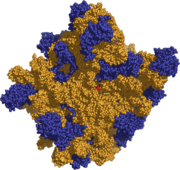RNA and DNA differ in three main ways. First, unlike DNA which is double-stranded, RNA is a single-stranded molecule in most of its biological roles and has a much shorter chain of nucleotides. Second, while DNA contains deoxyribose, RNA contains ribose, (there is no hydroxyl group attached to the pentose ring in the 2' position in DNA). These hydroxyl groups make RNA less stable than DNA because it is more prone to hydrolysis. Third, the complementary nucleotide to adenine is not thymine, as it is in DNA, but rather uracil, which is an unmethylated form of thymine.[13]

The
50S ribosomal subunit. RNA is in orange, protein in blue. The active site is in the middle (red).
Like DNA, most biologically active RNAs including tRNA, rRNA, snRNAs and other, non-coding, RNAs are extensively base paired to form double stranded helices. Structural analysis of these RNAs have revealed that they are highly structured. Unlike DNA, this structure is not long double-stranded helices but rather collections of short helices packed together into structures akin to proteins. In this fashion, RNAs can achieve chemical
catalysis, like enzymes.
[14] For instance, determination of the structure of the ribosome—an enzyme that catalyzes peptide bond formation—revealed that its active site is composed entirely of RNA.
http://en.wikipedia.org/wiki/RNA


No comments:
Post a Comment